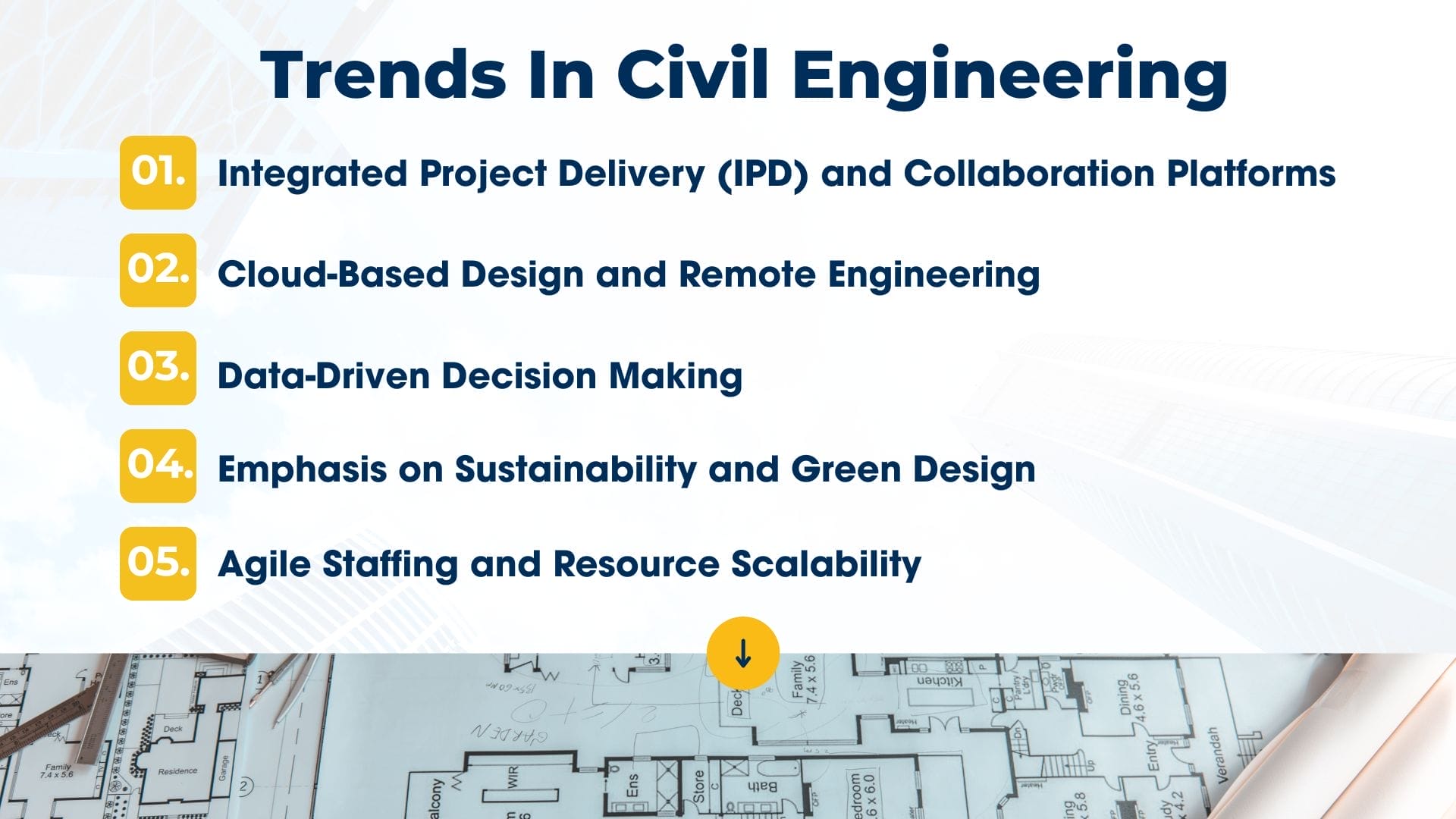In the ever-evolving field of civil engineering, staying competitive requires more than just internal innovation, it demands strategic partnerships and flexible operations. One of the most transformative strategies gaining momentum is outsourcing. As firms face increasing pressure to deliver high-quality infrastructure projects faster and more efficiently, outsourcing has emerged as a game-changing trend. By collaborating with specialized external service providers, civil engineering companies can unlock new levels of agility, innovation, and cost efficiency.
This blog dives into the latest trends in civil engineering outsourcing, examining how this practice is reshaping industry standards, redefining value creation, and setting new benchmarks for project execution.
The Growing Role of Outsourcing in Civil Engineering
When civil engineering firms adapt to changing markets, they often focus on digital upgrades and process innovation. But outsourcing has become an equally powerful lever for success, influencing many of the trends in civil engineering that define the modern project lifecycle.
A Strategic Response to Industry Shifts
When civil engineering firms look to adapt to market dynamics, they often focus on technological upgrades, process optimization, and workforce development. While these strategies remain critical, outsourcing presents an alternative and often complementary route to operational excellence, aligning perfectly with emerging trends in civil engineering.
Why Outsourcing is on the Rise
A closer look at the trends in civil engineering outsourcing reveals why this strategy is gaining ground:
-
Specialization of Outsourced Providers:
External engineering firms have honed their expertise in niche areas such as drainage systems, utility design, BIM modeling, and construction documentation. This specialization allows them to deliver superior outcomes, often faster and at a lower cost. -
Technological Acceleration:
As new tools like Civil 3D, GIS, and AI-based simulations become industry standards, maintaining in-house proficiency in all of them can be resource-intensive. Outsourcing enables firms to access these technologies without the overhead, aligning with digital transformation trends in civil engineering.
-
Global Workforce Integration:
With remote collaboration now normalized, companies are tapping into talent pools worldwide. This access helps solve skill gaps while also offering cost and time zone advantages, one of the growing trends in civil engineering project management.

Trends in Civil Engineering Outsourcing In 2025
The landscape of civil engineering outsourcing has undergone a significant transformation. No longer is it merely a cost-cutting measure for routine tasks; it has evolved into a strategic approach that fosters innovation, efficiency, and adaptability. Let’s delve into the prominent trends shaping this evolution.
Integrated Project Delivery (IPD) and Collaboration Platforms
The traditional model of outsourcing, characterized by isolated task delegation, is giving way to a more collaborative approach. Integrated Project Delivery (IPD) emphasizes the collective involvement of all stakeholders like owners, designers, contractors, and outsourced teams, from the project’s inception. This methodology promotes shared responsibilities, risks, and rewards, leading to enhanced trust and transparency.
One of the most defining trends in civil engineering is the shift toward collaboration. Tools like Autodesk BIM 360, Asana, and Monday.com enable real-time communication, document sharing, and progress tracking. These platforms ensure that outsourced teams are seamlessly integrated into the project’s workflow, allowing for immediate feedback, swift decision-making, and cohesive progress across all fronts.
Cloud-Based Design and Remote Engineering
The advent of cloud computing has revolutionized the way civil engineering projects are executed. Cloud-based design tools allow engineers and designers to access, modify, and share project files from any location, fostering a truly global collaborative environment.
Remote engineering teams can now work concurrently on various aspects of a project, such as stormwater management plans or grading designs, without the constraints of geographical boundaries. Real-time markups and instant updates ensure that all team members are aligned, reducing delays and enhancing overall productivity.
Data-Driven Decision Making
In the modern era, data is a critical asset in civil engineering. Firms are increasingly outsourcing data analytics tasks, including traffic modeling and environmental impact assessments, to specialized partners proficient in data science. This collaboration enables the integration of advanced analytical tools and methodologies into the engineering process.
By leveraging data-driven insights, firms can make informed decisions that enhance design efficiency, optimize resource allocation, and ensure sustainability. The ability to predict potential challenges and assess various scenarios through data analytics significantly improves project outcomes and client satisfaction.
Emphasis on Sustainability and Green Design
Sustainability has transitioned from a peripheral concern to a central tenet in civil engineering. Outsourcing firms are now expected to possess expertise in environmentally friendly design practices, such as LEED certification and low-impact development strategies.
Collaborating with partners who prioritize green design allows firms to meet regulatory requirements, reduce environmental footprints, and align with global Environmental, Social, and Governance (ESG) goals. This emphasis on sustainability not only benefits the environment but also enhances the firm’s reputation and appeal to eco-conscious clients.
Agile Staffing and Resource Scalability
The dynamic nature of civil engineering projects necessitates flexibility in staffing and resource allocation. Outsourcing provides firms with the ability to scale their workforce up or down based on project demands, without the long-term commitments associated with full-time hires.
This agility is particularly beneficial for firms managing multiple contracts or public-private partnership projects with stringent deadlines. By accessing a global talent pool, firms can quickly onboard specialized professionals to address specific project needs, ensuring timely and efficient project delivery.

Realized Benefits of Civil Engineering Outsourcing
Outsourcing in civil engineering offers a multitude of tangible benefits that contribute to a firm’s competitive edge. These advantages are closely intertwined with the prevailing trends in the industry.
Access to Highly Specialized Talent
Modern infrastructure projects often require specialized knowledge and proficiency in various software and technical standards. Outsourcing enables firms to tap into a global network of professionals skilled in platforms like Civil 3D, MicroStation, and BIM, among others.
This access to specialized talent eliminates the need for extensive training and accelerates project timelines. Firms can leverage the expertise of these professionals to enhance the quality and precision of their projects, ensuring compliance with local regulations and industry best practices.
Accelerated Timelines and Faster Delivery
Time efficiency is paramount in civil engineering. Outsourcing facilitates the division of labor across different time zones, allowing for continuous progress on projects. While one team completes tasks during their workday, another team in a different region can pick up where they left off, ensuring round-the-clock productivity.
This continuous workflow significantly reduces project timelines, enabling faster delivery without compromising quality. The ability to meet tight deadlines enhances client satisfaction and positions the firm as a reliable and efficient service provider.
Cost Optimization Without Compromising Quality
Outsourcing offers substantial cost savings by reducing expenses related to software licenses, office space, and full-time salaries. However, these savings do not come at the expense of quality. Reputable outsourcing firms implement rigorous quality assurance protocols and review processes to maintain high standards.
By partnering with firms like AXA Engineers, which prioritize quality and adhere to stringent standards, companies can achieve cost optimization while delivering top-tier results. This balance between cost and quality is essential for maintaining competitiveness in the industry.
コアコンピタンスへの注力
Delegating specialized tasks to expert partners allows civil engineering firms to concentrate on their core competencies. Internal teams can focus on innovation, client relationship management, and strategic growth initiatives, areas that directly contribute to the firm’s long-term success.
This strategic allocation of resources ensures that the firm’s primary objectives are not overshadowed by ancillary tasks. By focusing on what they do best, firms can enhance their service offerings and strengthen their market position.

Navigating the Challenges of Outsourcing
While outsourcing presents numerous advantages, it also introduces certain challenges that must be proactively addressed to maximize its benefits.
Communication and Coordination
Geographical separation can lead to communication gaps and coordination issues. To mitigate these challenges, firms must establish clear communication protocols and utilize effective collaboration tools.
Implementing structured communication plans, regular updates, and utilizing platforms like Slack and Zoom can enhance transparency and ensure all stakeholders are aligned. At AXA Engineers, we prioritize continuous communication to maintain clarity and cohesion throughout the project lifecycle.
Quality Control and Consistency
Maintaining consistent quality across all deliverables is a common concern in outsourcing. Leading firms address this by implementing multi-stage review processes, internal audits, and version control systems.
These measures ensure that any discrepancies are identified and rectified before reaching the client, maintaining the integrity and reliability of the project’s outcomes.
Cultural and Regulatory Differences
Outsourcing across international borders introduces cultural nuances and varying regulatory standards. To navigate these differences, firms must collaborate with partners who possess localized knowledge and an understanding of regional compliance requirements.
At AXA Engineers, we maintain teams with expertise in both global best practices and local regulations, ensuring that projects are executed with cultural sensitivity and regulatory adherence.
続きを読む:
The Baptist Development – AXA Engineersによる注目のプロジェクト
From data-driven designs and cloud collaboration to sustainable engineering and agile staffing, the trends in civil engineering outsourcing are here to stay. Firms that adopt outsourcing not just as a cost solution but as a growth strategy are better positioned to thrive in a dynamic market.
At AXA Engineers, we partner with civil engineering companies worldwide to provide scalable, high-quality design support across a range of services. Whether you’re looking to expedite timelines, access niche expertise, or boost design efficiency, outsourcing offers a pathway to future-ready operations.




